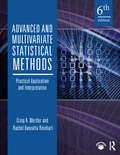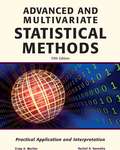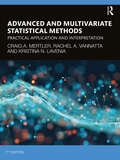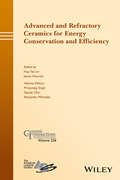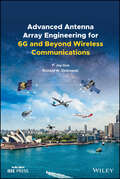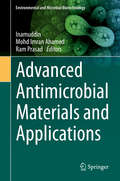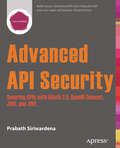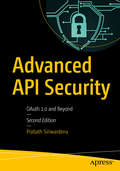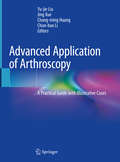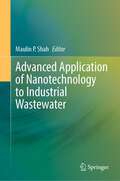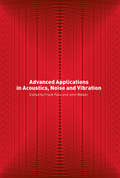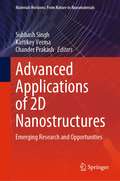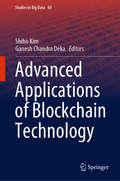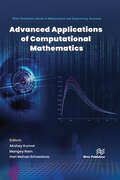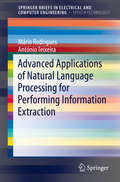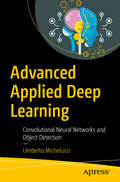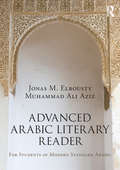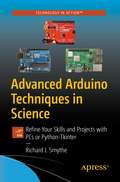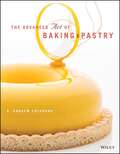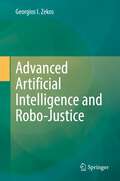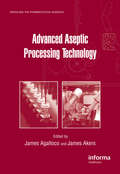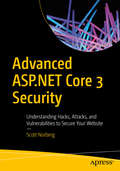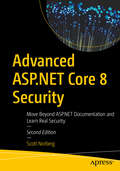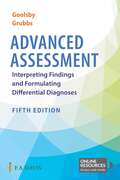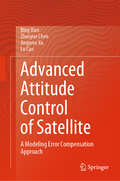- Table View
- List View
Advanced and Multivariate Statistical Methods: Practical Application and Interpretation
by Craig A. Mertler Rachel Vannatta Reinhart* All the statistics traditionally covered in a second-level course are included. * Stresses the conceptual and practical aspects for students who do not need emphasis on the underlying mathematical theory. * Students learn not only the purpose of and how to compute the statistics using SPSS, they also learn the logic behind the techniques and how to test the underlying assumptions. * Students are shown how to interpret, present, and write up the results for each technique. * Exercises allow students to practice their newly acquired skills. The answer key will be provided with professors' copies. * If your students are overwhelmed by advanced statistics texts that are too technical and mathematical, you should examine this highly applied approach to multivariate statistics. Covers why, what, when and how. Ideal for nonmath majors. * The numerous screenshots and examples of output make it easy for students to follow the text. * Each statistical method is followed by an explanation of why a student might use that method, including a discussion of its purpose and sample research questions it can address. * The authors also show a sample study with an example of how to write up the results. Students see firsthand how to present their statistical findings. * Although SPSS is the program that is illustrated, students using any program will benefit greatly from the conceptual material.
Advanced and Multivariate Statistical Methods: Practical Application and Interpretation Fifth Edition
by Craig A. Mertler Rachel A. Vannatta* All the statistics traditionally covered in a second-level course are included. * Stresses the conceptual and practical aspects for students who do not need emphasis on the underlying mathematical theory. * Students learn not only the purpose of and how to compute the statistics using SPSS, they also learn the logic behind the techniques and how to test the underlying assumptions. * Students are shown how to interpret, present, and write up the results for each technique. * Exercises allow students to practice their newly acquired skills. The answer key will be provided with professors' copies. * If your students are overwhelmed by advanced statistics texts that are too technical and mathematical, you should examine this highly applied approach to multivariate statistics. Covers why, what, when and how. Ideal for nonmath majors. * The numerous screenshots and examples of output make it easy for students to follow the text. * Each statistical method is followed by an explanation of why a student might use that method, including a discussion of its purpose and sample research questions it can address. * The authors also show a sample study with an example of how to write up the results. Students see firsthand how to present their statistical findings. * Although SPSS is the program that is illustrated, students using any program will benefit greatly from the conceptual material.
Advanced and Multivariate Statistical Methods: Practical Application and Interpretation
by Craig A. Mertler Rachel A. Vannatta Kristina N. LaVeniaAdvanced and Multivariate Statistical Methods, Seventh Edition provides conceptual and practical information regarding multivariate statistical techniques to students who do not necessarily need technical and/or mathematical expertise in these methods. This text has three main purposes. The first purpose is to facilitate conceptual understanding of multivariate statistical methods by limiting the technical nature of the discussion of those concepts and focusing on their practical applications. The second purpose is to provide students with the skills necessary to interpret research articles that have employed multivariate statistical techniques. Finally, the third purpose of AMSM is to prepare graduate students to apply multivariate statistical methods to the analysis of their own quantitative data or that of their institutions. New to the Seventh Edition All references to SPSS have been updated to Version 27.0 of the software. A brief discussion of practical significance has been added to Chapter 1. New data sets have now been incorporated into the book and are used extensively in the SPSS examples. All the SPSS data sets utilized in this edition are available for download via the companion website. Additional resources on this site include several video tutorials/walk-throughs of the SPSS procedures. These "how-to" videos run approximately 5–10 minutes in length. Advanced and Multivariate Statistical Methods was written for use by students taking a multivariate statistics course as part of a graduate degree program, for example in psychology, education, sociology, criminal justice, social work, mass communication, and nursing.
Advanced and Refractory Ceramics for Energy Conservation and Efficiency: Ceramic Transactions, Volume 256
by Tatsuki Ohji Alexander Michaelis Hua-Tay Lin Mrityunjay Singh James HemrickThis volume contains a collection of 19 papers from the 11th International Symposium on Ceramic Materials and Components for Energy and Environmental Applications (CMCEE-11), June 14-19, 2015 in Vancouver, BC, Canada. Papers were presented in the below five symposia from Track 2 on the topic of Ceramics for Energy Conservation and Efficiency: Advanced Ceramics and Composites for Gas Turbine Engines Advanced Refractory Ceramic Materials and Technologies Advanced Ceramic Coatings for Power Systems Energy Efficient Advanced Bearings and Wear Resistant Materials Advanced Nitrides and Related Materials for Energy Applications
Advanced Antenna Array Engineering for 6G and Beyond Wireless Communications
by Yingjie Jay Guo Richard W. ZiolkowskiAdvanced Antenna Array Engineering for 6G and Beyond Wireless Communications Reviews advances in the design and deployment of antenna arrays for future generations of wireless communication systems, offering new solutions for the telecommunications industry Advanced Antenna Array Engineering for 6G and Beyond Wireless Communications addresses the challenges in designing and deploying antennas and antenna arrays which deliver 6G and beyond performance with high energy efficiency and possess the capability of being immune to interference caused by different systems mounted on the same platforms. This timely and authoritative volume presents innovative solutions for developing integrated communications networks of high-gain, individually-scannable, multi-beam antennas that are reconfigurable and conformable to all platforms, thus enabling the evolving integrated land, air and space communications networks. The text begins with an up-to-date discussion of the engineering issues facing future wireless communications systems, followed by a detailed discussion of different beamforming networks for multi-beam antennas. Subsequent chapters address problems of 4G/5G antenna collocation, discuss differentially-fed antenna arrays, explore conformal transmit arrays for airborne platforms, and present latest results on fixed frequency beam scanning leaky wave antennas as well as various analogue beam synthesizing strategies. Based primarily on the authors’ extensive work in the field, including original research never before published, this important new volume: Reviews multi-beam feed networks, array decoupling and de-scattering methods Provides a systematic study on differentially fed antenna arrays that are resistant to interference caused by future multifunctional/multi-generation systems Features previously unpublished material on conformal transmit arrays based on Huygen’s metasufaces and reconfigurable leaky wave antennas Includes novel algorithms for synthesizing and optimizing thinned massive arrays, conformal arrays, frequency invariant arrays, and other future arrays Advanced Antenna Array Engineering for 6G and Beyond Wireless Communications is an invaluable resource for antenna engineers and researchers, as well as graduate and senior undergraduate students in the field.
Advanced Antimicrobial Materials and Applications (Environmental and Microbial Biotechnology)
by Inamuddin Mohd Imran Ahamed Ram PrasadSurface bio-contamination has become a severe problem that contributes to outbreaks of community acquired and nosocomial infections through contiguous fomite transmission of diseases. Every year, thousands of patients die due to nosocomial infections by pathogens. It is therefore essential to develop novel strategies to prevent or improve the treatment of biomaterial concomitant infections. The concept of antimicrobial materials is becoming increasingly important not only in the hospital and healthcare environments, but also for laboratories, home appliances, and certain industrial applications. Materials are now being developed to prevent the buildup, spread and transfer of harmful microbes, and to dynamically deactivate them. Drawing on research and examples from around the world, this book highlights the latest advances in, and applications of, antibacterial biomaterials for biomedical devices, and focuses on metals with antibacterial coatings/surfaces, antibacterial stainless steels and other commonly used antibacterial materials. It also discusses the role of innovative approaches and provides a comprehensive overview of cutting-edge research on the processing, properties and technologies involved in the development of antimicrobial applications. Given its scope, the book will be of interest to researchers and policymakers, as well as undergraduate and graduate students of biochemistry, microbiology, and environmental chemistry
Advanced API Security: Securing APIs with OAuth 2.0, OpenID Connect, JWS, and JWE
by Prabath SiriwardenaAdvanced API Security is a complete reference to the next wave of challenges in enterprise security--securing public and private APIs. API adoption in both consumer and enterprises has gone beyond predictions. It has become the 'coolest' way of exposing business functionalities to the outside world. Both your public and private APIs, need to be protected, monitored and managed. Security is not an afterthought, but API security has evolved a lot in last five years. The growth of standards, out there, has been exponential. That's where AdvancedAPI Security comes in--to wade through the weeds and help you keep the bad guys away while realizing the internal and external benefits of developing APIs for your services. Our expert author guides you through the maze of options and shares industry leading best practices in designing APIs for rock-solid security. The book will explain, in depth, securing APIs from quite traditional HTTP Basic Authentication to OAuth 2. 0 and the standards built around it. Build APIs with rock-solid security today with Advanced API Security. Takes you through the best practices in designing APIs for rock-solid security. Provides an in depth tutorial of most widely adopted security standards for API security. Teaches you how to compare and contrast different security standards/protocols to find out what suits your business needs the best.
Advanced API Security: OAuth 2.0 and Beyond
by Prabath SiriwardenaPrepare for the next wave of challenges in enterprise security. Learn to better protect, monitor, and manage your public and private APIs. Enterprise APIs have become the common way of exposing business functions to the outside world. Exposing functionality is convenient, but of course comes with a risk of exploitation. This book teaches you about TLS Token Binding, User Managed Access (UMA) 2.0, Cross Origin Resource Sharing (CORS), Incremental Authorization, Proof Key for Code Exchange (PKCE), and Token Exchange. Benefit from lessons learned from analyzing multiple attacks that have taken place by exploiting security vulnerabilities in various OAuth 2.0 implementations. Explore root causes, and improve your security practices to mitigate against similar future exploits. Security must be an integral part of any development project. This book shares best practices in designing APIs for rock-solid security. API security has evolved since the first edition of this book, and the growth of standards has been exponential. OAuth 2.0 is the most widely adopted framework that is used as the foundation for standards, and this book shows you how to apply OAuth 2.0 to your own situation in order to secure and protect your enterprise APIs from exploitation and attack. What You Will LearnSecurely design, develop, and deploy enterprise APIsPick security standards and protocols to match business needsMitigate security exploits by understanding the OAuth 2.0 threat landscapeFederate identities to expand business APIs beyond the corporate firewallProtect microservices at the edge by securing their APIsDevelop native mobile applications to access APIs securelyIntegrate applications with SaaS APIs protected with OAuth 2.0Who This Book Is ForEnterprise security architects who are interested in best practices around designing APIs. The book is also for developers who are building enterprise APIs and integrating with internal and external applications.
Advanced Application of Arthroscopy: A Practical Guide with Illustrative Cases
by Yu-Jie Liu Jing Xue Chang-Ming Huang Chun-Bao LiThis book provides arthroscopy techniques and applications to clinical practitioners, including sports medicine therapeutics, orthopaedic surgeons, specialist training candidates, rehabilitation clinicians. It also includes small incisions per minimally invasive surgery using a camera mounted on a thin tube to visualize, repair and reconstruct joint-associated structures. Arthroscopy technique as a minimally invasive surgical method, in Orthopeadics is not only for the treatment of intra-articular diseases but also an advanced conception for treatment of extra-articular diseases and peri-articular fractures. After performing years of arthroscopy, authors intend to provide an elite technique demonstration of each procedure, including indications, technique, complications, and results. There are three main parts of the book, including the extra-articular application of arthroscopy techniques, arthroscopic minimally invasive techniques for the treatment of intra-articular fractures, and Innovative technology for repair and reconstruction of bone and joint injuries. Key technical points and experience of arthroscopic repair of joint injuries, dislocation of joints, fixation of the intra-articular fractures, ligament release for limbs are illustrated. Special situations such as congenital torticollis, deltoid contracture, gluteal muscle contracture, bone grafting, removal of locking plate and screw and benign tumors treatment are also included.
Advanced Application of Nanotechnology to Industrial Wastewater
by Maulin P. ShahThis book discusses new and innovative trends and techniques in the application of nanotechnology to industrial wastewater treatment both at a laboratory scale and an industry scale, including treatment, remediation, sensing and pollution prevention. The book also explores unique physicochemical and surface properties of nanoparticles; it highlights advantages they provide for engineering applications. Each chapter covers a different nanotechnology-based approach and examines basic principles, practical applications, recent breakthroughs and associated limitations. Nanotechnology applications to wastewater research have significant impact in maintaining the long-term quality, availability and viability of water. Regardless of the origin—for example, municipal or industrial wastewater—the remediation nanotechnology allows water to be recycled and desalinized in addition to simultaneously detecting biological and chemical contamination. The book describes a broad area of nanotechnology and water research where membrane processes (nanofiltration, ultrafiltration, reverse osmosis and nanoreactive membranes) are considered key components of advanced water purification and desalination technologies that remove, reduce or neutralize water contaminants. Various nanoparticles and nanomaterials that could be used in water remediation (zeolites, carbon nanotubes, self-assembled monolayers on mesoporous supports, biopolymers, single-enzyme nanoparticles, zero-valent iron nanoparticles, bimetallic iron nanoparticles and nanoscale semiconductor photocatalysts) are also discussed. This book is beneficial for students and academicians to understand the recent research advancements in the field.
Advanced Applications in Acoustics, Noise and Vibration
by Frank Fahy John WalkerAdvanced Applications in Acoustics, Noise and Vibration provides comprehensive and up-to-date overviews of knowledge, applications and research activities in a range of topics that are of current interest in the practice of engineering acoustics and vibration technology. The thirteen chapters are grouped into four parts: signal processing, acoustic modelling, environmental and industrial acoustics, and vibration.Following on from its companion volume Fundamentals of Noise and Vibration this book is based partly on material covered in a selection of elective modules in the second semester of the Masters programme in 'Sound and Vibration Studies' of the Institute of Sound and Vibration Research at the University of Southampton, UK and partly on material presented in the annual ISVR short course 'Advanced Course in Acoustics, Noise and Vibration'.
Advanced Applications of 2D Nanostructures: Emerging Research and Opportunities (Materials Horizons: From Nature to Nanomaterials)
by Subhash Singh Kartikey Verma Chander PrakashThis book focuses on both recent advances and the applications of two-dimensional (2D) nanomaterials in different fields. This book encapsulates all the aspects related to 2D nanomaterials and their applications. It provides scientific and technological insights on novel routes of design and fabrication of few layered nanostructures and their hetero structures based on a variety of 2-D layered materials. It also covers a wide range of industrial applications of 2D nanomaterials. It emphasizes on the detailing of the various characterization techniques used. The book will be a valuable reference for beginners, researchers, and professionals interested in nano-materials and allied fields.
Advanced Applications of Blockchain Technology (Studies in Big Data #60)
by Shiho Kim Ganesh Chandra DekaThis contributed volume discusses diverse topics to demystify the rapidly emerging and evolving blockchain technology, the emergence of integrated platforms and hosted third-party tools, and the development of decentralized applications for various business domains. It presents various applications that are helpful for research scholars and scientists who are working toward identifying and pinpointing the potential of as well as the hindrances to this technology.
Advanced Applications of Computational Mathematics: Theoretical Advances And Advanced Applications (De Gruyter Series On The Applications Of Mathematics In Engineering And Information Sciences Ser. #3)
by Akshay Kumar Mangey Ram Hari Mohan SrivastavaThis book “Advanced Applications of Computational Mathematics” covers multidisciplinary studies containing advanced research in the field of computational and applied mathematics. The book includes research methodology, techniques, applications, and algorithms. The book will be very useful to advanced students, researchers and practitioners who are involved in the areas of computational and applied mathematics and engineering.
Advanced Applications of Natural Language Processing for Performing Information Extraction (SpringerBriefs in Speech Technology)
by António Teixeira Mário RodriguesThis book explains how can be created information extraction (IE) applications that are able to tap the vast amount of relevant information available in natural language sources: Internet pages, official documents such as laws and regulations, books and newspapers, and social web. Readers are introduced to the problem of IE and its current challenges and limitations, supported with examples. The book discusses the need to fill the gap between documents, data, and people, and provides a broad overview of the technology supporting IE. The authors present a generic architecture for developing systems that are able to learn how to extract relevant information from natural language documents, and illustrate how to implement working systems using state-of-the-art and freely available software tools. The book also discusses concrete applications illustrating IE uses. · Provides an overview of state-of-the-art technology in information extraction (IE), discussing achievements and limitations for the software developer and providing references for specialized literature in the area · Presents a comprehensive list of freely available, high quality software for several subtasks of IE and for several natural languages · Describes a generic architecture that can learn how to extract information for a given application domain
Advanced Applied Deep Learning: Convolutional Neural Networks and Object Detection
by Umberto MichelucciDevelop and optimize deep learning models with advanced architectures. This book teaches you the intricate details and subtleties of the algorithms that are at the core of convolutional neural networks. In Advanced Applied Deep Learning, you will study advanced topics on CNN and object detection using Keras and TensorFlow. Along the way, you will look at the fundamental operations in CNN, such as convolution and pooling, and then look at more advanced architectures such as inception networks, resnets, and many more. While the book discusses theoretical topics, you will discover how to work efficiently with Keras with many tricks and tips, including how to customize logging in Keras with custom callback classes, what is eager execution, and how to use it in your models. Finally, you will study how object detection works, and build a complete implementation of the YOLO (you only look once) algorithm in Keras and TensorFlow. By the end of the book you will have implemented various models in Keras and learned many advanced tricks that will bring your skills to the next level.What You Will Learn See how convolutional neural networks and object detection workSave weights and models on diskPause training and restart it at a later stage Use hardware acceleration (GPUs) in your codeWork with the Dataset TensorFlow abstraction and use pre-trained models and transfer learningRemove and add layers to pre-trained networks to adapt them to your specific projectApply pre-trained models such as Alexnet and VGG16 to new datasets Who This Book Is For Scientists and researchers with intermediate-to-advanced Python and machine learning know-how. Additionally, intermediate knowledge of Keras and TensorFlow is expected.
Advanced Arabic Literary Reader: For Students of Modern Standard Arabic
by Jonas Elbousty Muhammad AzizAdvanced Arabic Literary Reader is a truly representative collection of literary extracts from across the Arabic-speaking world. Extracts from each country in the Arab world have been carefully selected, with a balance of both male and female writers and prominent and emerging voices, providing a unique window into the Arab world. ? Suitable for both class use and independent study, each extract is supported by an introduction to the author, pre-reading activities, comprehension questions and discussion questions. These activities are designed to help learners expand and reinforce their vocabulary, develop their oral and written proficiency and stimulate further exploration of the cultural and historical background of the texts. ? Written entirely in Arabic, the Advanced Arabic Literary Reader is an essential text for advanced students who wish to further their reading, speaking, and writing ability in Modern Standard Arabic. Free audio recordings of the extracts are available online at www.routledge.com/books/details/9781138828698/ to enable students to improve listening skills.
Advanced Arduino Techniques in Science: Refine Your Skills and Projects with PCs or Python-Tkinter
by Richard J. SmytheIf you’re already a comfortable programmer, familiar with your single board computer and microcontroller, and are ready to refine your projects, then let’s get started! This book covers advanced methods and techniques for creating, implementing, monitoring and controlling your experiments and projects with your Raspberry Pi and Arduino. Projects will use Python and the Tkinter GUI and will also cover software development for adding real time data display to the Raspberry Pi.You'll review concepts of frequency occurring in nature and the techniques used to measure the frequency of electrically varying signal voltages. You'll also study procedures for safe design, implementation and operation of experimental measurement systems operating at high heats and high temperatures. Throughout the book you'll look at sources and types of errors, and best practices for minimizing and reducing them.Often times there are simple environmental issues hindering what would seem to be simple projects: high temperatures, controlling the power for elevated temperature with the proportional integral and derivative (PID) algorithm, and the limitations imposed by eight bit code, the influence of noise and errors in measured data, and many more. Advanced Arduino Techniques in Science provides the best tools to move past those restrictions. What You’ll LearnImplement an experimental control system and graphical data display for the Raspberry Pi and ArduinoManage experimental control with PID algorithm implementation, tuning and limitations imposed by eight bit digital signalsBuild an analytical front end Examine data smoothing capability of the Kalman filterExplore available methods for measuring both high and low frequency values in electronic signalsWho This Book Is ForEducators, researchers, students, makers, citizen scientists, or hobbyists can all extend their measuring capability or improve upon the quality of their collected data. The book is directed to those with intermediate skills in programming and those who are comfortable with Python programming and Arduino C.
The Advanced Art of Baking and Pastry
by R. Andrew ChlebanaThe main goal of this book is to present the right balance of topics and depth of coverage, encompassing items produced in the bakeshop, including breads, Viennoiserie, creams, pies, tarts, cakes, and decorative work in a professional manner that is easily approachable for the advanced baking and pastry student and professional. This is accomplished by providing theoretical information along with tested recipes and detailed step-by-step procedures. This approach to learning builds the student’s confidence and skills, as well as an increased understanding of the material. In addition, a supplemental recipe database will provide students with a foundation of recipes and techniques that they can then apply throughout their career. Professionals will also benefit from the wide variety of recipes and the techniques presented.
Advanced Artificial Intelligence and Robo-Justice
by Georgios I. ZekosThe book deals with digital technology which is transforming the landscape of dispute resolution. It illustrates the application of AI in the legal field and shows the future prospect of robo-justice for an AAI society in the advanced artificial intelligence era. In other words, the present justice system and the influence of current AI upon courts and arbitration are investigated. The transforming role of AI on all legal fields is examined thoroughly by giving answers concerning AI legal personality and liability. The analysis shows that digital technology is generating an ever-growing number of disputes and at the same time is challenging the effectiveness and reach of traditional dispute resolution avenues. To that extent, the book presents in tandem the impact of AI upon courts and arbitration, and reveals the role of AAI in generating a new robo-justice system.Finally, the end of the perplexing relation of courts and arbitration is evidenced methodically and comprehensively.
Advanced Aseptic Processing Technology (Drugs and the Pharmaceutical Sciences)
by James Agalloco James AkersThe preparation of sterile products using aseptic processing is considered perhaps the most critical process in the pharmaceutical industry and has witnessed continual improvement over the last half century. New approaches that have transformed classical aseptic production methods are appearing almost daily. This book reviews emerging technologies
Advanced ASP.NET Core 3 Security: Understanding Hacks, Attacks, and Vulnerabilities to Secure Your Website
by Scott NorbergIncorporate security best practices into ASP.NET Core. This book covers security-related features available within the framework, explains where these feature may fall short, and delves into security topics rarely covered elsewhere. Get ready to dive deep into ASP.NET Core 3.1 source code, clarifying how particular features work and addressing how to fix problems. For straightforward use cases, the ASP.NET Core framework does a good job in preventing certain types of attacks from happening. But for some types of attacks, or situations that are not straightforward, there is very little guidance available on how to safely implement solutions. And worse, there is a lot of bad advice online on how to implement functionality, be it encrypting unsafely hard-coded parameters that need to be generated at runtime, or articles which advocate for certain solutions that are vulnerable to obvious injection attacks. Even more concerning is the functions in ASP.NET Core that are not as secure as they should be by default.Advanced ASP.NET Core 3 Security is designed to train developers to avoid these problems. Unlike the vast majority of security books that are targeted to network administrators, system administrators, or managers, this book is targeted specifically to ASP.NET developers. Author Scott Norberg begins by teaching developers how ASP.NET Core works behind the scenes by going directly into the framework's source code. Then he talks about how various attacks are performed using the very tools that penetration testers would use to hack into an application. He shows developers how to prevent these attacks. Finally, he covers the concepts developers need to know to do some testing on their own, without the help of a security professional. What You Will Learn Discern which attacks are easy to prevent, and which are more challenging, in the frameworkDig into ASP.NET Core 3.1 source code to understand how the security services workEstablish a baseline for understanding how to design more secure softwareProperly apply cryptography in software developmentTake a deep dive into web security conceptsValidate input in a way that allows legitimate traffic but blocks malicious traffic Understand parameterized queries and why they are so important to ASP.NET CoreFix issues in a well-implemented solution Know how the new logging system in ASP.NET Core falls short of security needsIncorporate security into your software development process Who This Book Is ForSoftware developers who have experience creating websites in ASP.NET and want to know how to make their websites secure from hackers and security professionals who work with a development team that uses ASP.NET Core. A basic understanding of web technologies such as HTML, JavaScript, and CSS is assumed, as is knowledge of how to create a website, and how to read and write C#. You do not need knowledge of security concepts, even those that are often covered in ASP.NET Core documentation.
Advanced ASP.NET Core 8 Security: Move Beyond ASP.NET Documentation and Learn Real Security
by Scott NorbergMost .NET developers do not incorporate security best practices when creating websites. The problem? Even if you use all of the best practices that the ASP.NET team recommends, you are still falling short in several key areas due to issues within the framework itself. And most developers don’t use all of the best practices that are recommended. If you are interested in truly top-notch security, available sources don’t give you the information you need. Most blogs and other books simply state how to use the configurations within ASP.NET, but do not teach you security as understood by security professionals. Online code samples aren't much help because they are usually written by developers who aren’t incorporating security practices. This book solves those issues by teaching you security first, going over software best practices as understood by security professionals, not developers. Then it teaches you how security is implemented in ASP.NET. With that foundation, it dives into specific security-related functionality and discusses how to improve upon the default functionality with working code samples. And you will learn how security professionals build software security programs so you can continue building software security best practices into your own Secure Software Development Life Cycle (SSDLC). What You’ll Learn Know how both attackers and professional defenders approach web security Establish a baseline of security for understanding how to design more secure software Discern which attacks are easy to prevent, and which are more challenging, in ASP.NET Dig into ASP.NET source code to understand how the security services work Know how the new logging system in ASP.NET falls short of security needs Incorporate security into your software development process Who This Book Is For Software developers who have experience creating websites in ASP.NET and want to know how to make their websites secure from hackers and security professionals who work with a development team that uses ASP.NET. To get the most out of this book, you should already have a basic understanding of web programming and ASP.NET, including creating new projects, creating pages, and using JavaScript. Topics That Are New to This Edition This edition has been updated with the following changes: Best practices and code samples updated to reflect security-related changes in ASP.NET 8 Improved examples, including a fully-functional website incorporating security suggestions Best practices for securely using Large Language Models (LLMs) and AI Expansions and clarifications throughout
Advanced Assessment: Interpreting Findings And Formulating Differential Diagnoses
by Mary Jo Goolsby Laurie GrubbsYour essential guide in the assessment and diagnostic process. Step by step, you’ll hone your ability to perform effective health assessments, obtain valid data, interpret the findings, and recognize the range of conditions that can be indicated by specific findings to reach an accurate differential diagnosis. You’ll have coverage of 170 conditions and symptoms across the lifespan at your fingertips.
Advanced Attitude Control of Satellite: A Modeling Error Compensation Approach
by Bing Xiao Lu Cao Zhaoyue Chen Jingwen XuThis book focuses on the high-accuracy attitude control system design and approaches for satellite with modeling error including system uncertainties, actuator faults, and disturbances. It presents a systematically and almost self-contained description of the many facets of envisaging, designing, implementing, or experimentally exploring modeling error compensation-based attitude control of satellites. The advanced treatment of practical issues in satellite attitude compensation control is one of the major features of the book, which is particularly suited for readers who are interested to learn the latest solutions in attitude control system design of satellites. The book intends to provide a unified platform for understanding and applicability of the modeling error compensation-based attitude control for different purposes in aerospace engineering and some related fields. It can benefit researchers, engineers, and graduate students in the fields of attitude control of satellites and other unmanned systems, aerospace engineering, etc.
